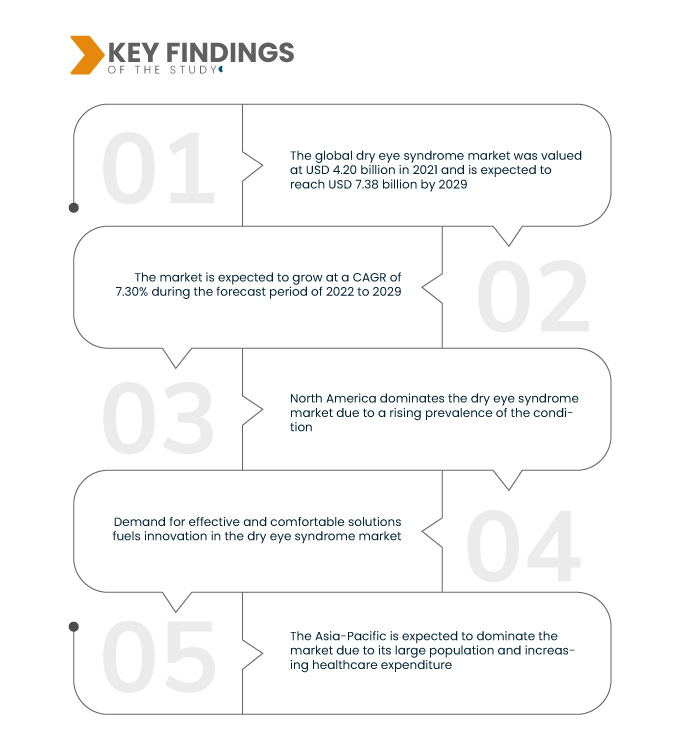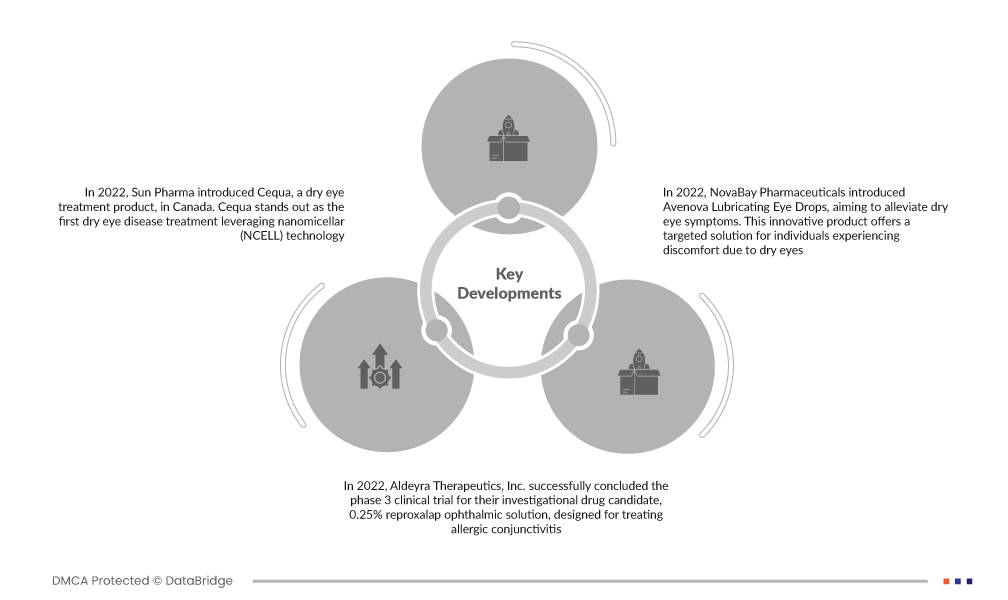안구건조증 시장은 눈물 자극제, 인공눈물, 분비촉진제 등 다양한 솔루션을 제공하며, 환자의 다양한 요구를 충족합니다. 이러한 제품들은 다양한 기전을 통해 증상 완화를 목표로 합니다. 액상, 반고형제 등 다양한 제형을 제공하여 개인 맞춤형 치료를 제공합니다. 이처럼 역동적인 시장은 환자의 편안함을 향상하고 안구건조증의 다면적인 특성을 해결하려는 노력을 반영하며, 개인의 선호도와 상태에 맞춘 다양하고 혁신적인 제품을 제공합니다.
https://databridgemarketresearch.com/reports/global-dry-eye-syndrome-market 에서 전체 보고서를 확인하세요.
데이터 브리지 마켓 리서치(Data Bridge Market Research)에 따르면, 세계 안구건조증 시장은 2021년 42억 달러 규모였으며, 2029년에는 73억 8천만 달러에 달할 것으로 예상됩니다. 2022년부터 2029년까지 예측 기간 동안 연평균 성장률(CAGR)은 7.30%에 달할 것으로 예상됩니다. 의료비 지출 급증은 안구건조증 시장을 크게 성장시켜 첨단 치료법의 개발 및 보급을 촉진합니다. 이러한 재정적 투자는 연구, 혁신, 그리고 최첨단 솔루션 도입을 지원하여 궁극적으로 안구건조증 환자의 치료 및 치료 결과를 개선합니다.
연구의 주요 결과
인구 고령화로 시장 성장률이 높아질 것으로 예상
고령 인구 증가는 안구건조증 시장의 핵심 동인으로, 안구건조증 위험 증가와 밀접한 관련이 있습니다. 나이가 들면서 생리적 변화와 연령 관련 요인의 유병률 증가가 안구건조증 증상에 영향을 미칩니다. 이러한 인구학적 추세는 효과적인 치료법에 대한 절실한 필요성을 강조하며, 노인의 안구건조증으로 인한 고유한 어려움을 해결하고 전반적인 환자 치료를 개선하기 위한 혁신적인 솔루션 개발에 시장의 관심이 집중되고 있습니다.
보고서 범위 및 시장 세분화
보고서 메트릭
|
세부
|
예측 기간
|
2022년부터 2029년까지
|
기준 연도
|
2021
|
역사적인 해
|
2020 (2014-2019년으로 맞춤 설정 가능)
|
양적 단위
|
매출(10억 달러), 볼륨(단위), 가격(USD)
|
다루는 세그먼트
|
제품 유형(눈물 자극제, 인공 눈물, 분비촉진제, 기타), 복용량 유형(액상, 반고형, 기타), 약물 분류(윤활제, 콜린제, 항염제, 항감염제, 항알레르기제, 기타), 복용량(1회 복용량, 다중 복용량), 약물 유형(처방약, 일반의약품), 용기 유형(1회 복용량 바이알, 병, 튜브), 포장 유형(플라스틱, 알루미늄, 유리), 유형(브랜드, 제네릭), 유통 채널(병원 약국, 소매 약국, 온라인 약국), 최종 사용자(병원, 홈 케어, 전문 클리닉, 기타)
|
포함 국가
|
미국, 북미의 캐나다 및 멕시코, 독일, 프랑스, 영국, 네덜란드, 스위스, 벨기에, 러시아, 이탈리아, 스페인, 터키, 유럽의 기타 유럽 국가, 중국, 일본, 인도, 한국, 싱가포르, 말레이시아, 호주, 태국, 인도네시아, 필리핀, 아시아 태평양(APAC)의 기타 아시아 태평양(APAC), 사우디아라비아, UAE, 남아프리카 공화국, 이집트, 이스라엘, 중동 및 아프리카(MEA)의 일부인 기타 중동 및 아프리카(MEA), 남미의 일부인 기타 남미 국가.
|
시장 참여자 포함
|
Eli Lilly and Company(미국), AstraZeneca(영국), Novartis AG(스위스), Johnson & Johnson Private Limited(미국), Teva Pharmaceutical Industries Ltd.(예루살렘), Merck & Co., Inc.(미국), Allergan(아일랜드), Bausch Health Companies Inc.(캐나다), Abbott(미국), F. Hoffmann-La Roche Ltd.(스위스), Pfizer Inc.(미국), GlaxoSmithKline plc(영국), Sanofi(프랑스), Merck KGaA(독일), Otsuka America Pharmaceutical, Inc.(미국), Akorn Operating Company LLC(미국), Allostera Pharma Inc.(캐나다), I-Med Pharma Inc.(캐나다), Santen Pharmaceuticals Co. Ltd.(일본), AFT Pharmaceuticals(뉴질랜드), Novaliq GmbH(독일)
|
보고서에서 다루는 데이터 포인트
|
Data Bridge Market Research에서 큐레이팅한 시장 보고서에는 시장 가치, 성장률, 세분화, 지리적 적용 범위, 주요 기업 등 시장 시나리오에 대한 통찰력 외에도 심층적인 전문가 분석, 환자 역학, 파이프라인 분석, 가격 분석, 규제 프레임워크가 포함됩니다.
|
세그먼트 분석:
글로벌 건조증 시장은 제품 유형, 복용량 유형, 약물 종류, 복용량, 약물 유형, 용기 유형, 포장 유형, 유형, 최종 사용자 및 유통 채널을 기준으로 세분화됩니다.
- 제품 유형을 기준으로 글로벌 건조증 시장은 눈물 자극제, 인공 눈물, 분비 촉진제 및 기타로 세분화됩니다.
- 글로벌 건조안증후군 시장은 복용량 유형에 따라 액체형, 반고체형 및 기타형으로 구분됩니다.
- 약물 분류에 따라 글로벌 건조증 시장은 항염제, 윤활제, 항감염제, 항알레르기제, 콜린제 및 기타로 세분화됩니다.
- 용량 기준으로 글로벌 건조증 시장은 다중 용량과 단위 용량으로 구분됩니다.
- 약물 유형을 기준으로 글로벌 건조증 시장은 처방약(RX)과 일반의약품(OTC)으로 구분됩니다.
- 용기 유형을 기준으로 글로벌 건조증 시장은 단위 용량 바이알, 병 및 튜브로 세분화됩니다.
- 포장 유형을 기준으로 글로벌 건조증 시장은 플라스틱, 유리 및 알루미늄으로 구분됩니다.
- 글로벌 건조증 시장은 유형을 기준으로 제네릭과 브랜드로 구분됩니다.
- 최종 사용자를 기준으로 글로벌 건조증 시장은 병원, 전문 클리닉, 재택 치료 및 기타로 세분화됩니다.
- 유통 채널을 기준으로 글로벌 건조증 시장은 병원 약국, 소매 약국, 온라인 약국 및 기타로 세분화되었습니다.
주요 플레이어
Data Bridge Market Research는 글로벌 건조안 증후군 시장의 글로벌 건조안 증후군 시장 참여자로 다음 회사를 인식합니다. Eli Lilly and Company(미국), AstraZeneca(영국), Novartis AG(스위스), Johnson & Johnson Private Limited(미국), Teva Pharmaceutical Industries Ltd.(예루살렘), Merck & Co., Inc.(미국).
시장 개발
- 2022년, 선 파마(Sun Pharma)는 캐나다에서 안구건조증 치료제인 세쿠아(Cequa)를 출시했습니다. 세쿠아는 나노마이셀(NCELL) 기술을 활용한 최초의 안구건조증 치료제로 주목을 받고 있습니다. 이 혁신적인 접근법은 사이클로스포린의 생체이용률과 물리화학적 안정성을 향상시켜 안구 조직 내 침투력을 향상시킵니다. 이번 출시는 안구건조증 치료에 있어 획기적인 진전을 의미하며, 향상된 치료 효능과 안구 전달 정밀도를 갖춘 효과적인 치료 옵션을 제공합니다.
- 2022년, 알데이라 테라퓨틱스(Aldeyra Therapeutics, Inc.)는 알레르기성 결막염 치료를 위해 개발 중인 신약 후보물질인 0.25% 레프록살랍 점안액의 3상 임상시험을 성공적으로 완료했습니다. 알데이라는 미국 검안학회(American Academy of Optometry) 2022 연례 학술대회에서 해당 임상시험의 임상 데이터를 발표하며, 엄격한 임상 평가와 설득력 있는 연구 결과 발표를 통해 알레르기성 결막염 치료의 잠재적인 가능성을 발전시키는 데 중요한 이정표를 세웠습니다.
- 2022년, 노바베이 파마슈티컬스(NovaBay Pharmaceuticals)는 안구건조증 증상 완화를 목표로 아베노바 윤활 점안액을 출시했습니다. 이 혁신적인 제품은 안구건조증으로 인한 불편함을 겪는 사람들에게 맞춤형 솔루션을 제공합니다. 아베노바 윤활 점안액은 안구건조증 치료 시장의 성장에 기여하며, 환자들에게 안구 수분을 공급하고 이러한 흔한 안구 질환과 관련된 증상을 완화하는 믿을 수 있는 대안을 제공합니다.
지역 분석
지리적으로, 글로벌 건조안 증후군 시장 보고서에서 다루는 국가는 다음과 같습니다. 북미에서는 미국, 캐나다, 멕시코, 유럽의 독일, 프랑스, 영국, 네덜란드, 스위스, 벨기에, 러시아, 이탈리아, 스페인, 터키, 유럽의 기타 유럽 국가, 중국, 일본, 인도, 한국, 싱가포르, 말레이시아, 호주, 태국, 인도네시아, 필리핀, 아시아 태평양(APAC)의 기타 아시아 태평양(APAC), 사우디아라비아, UAE, 남아프리카 공화국, 이집트, 이스라엘, 중동 및 아프리카(MEA)의 일부인 기타 중동 및 아프리카(MEA), 남미의 일부인 기타 남미.
Data Bridge Market Research 분석에 따르면:
북미는 2022-2029년 예측 기간 동안 글로벌 건조증 시장에서 지배적인 지역입니다.
북미 지역은 안구건조증 유병률 증가로 안구건조증 시장을 장악하고 있습니다. 주요 업계 기업들이 혁신 기술에 더욱 집중하고 있는 것도 이 지역의 우위를 뒷받침합니다. 새로운 솔루션을 향한 이러한 노력은 시장 성장률을 높이는 데 기여하고 있으며, 이는 첨단 치료 및 기술 도입을 통해 안구건조증으로 인한 문제를 해결하려는 북미 지역의 노력을 보여줍니다.
아시아 태평양 지역은 2022-2029년 예측 기간 동안 글로벌 건조증 시장을 주도할 것으로 예상됩니다 .
아시아 태평양 지역은 인구가 많고 의료비 지출이 증가함에 따라 의료 시장을 주도할 것으로 예상됩니다. 상당한 인구 기반을 바탕으로 의료 투자 증가는 의료 서비스와 기술 확장에 기여합니다. 이러한 요인들의 융합은 아시아 태평양 지역을 예측 기간 동안 핵심 성장 동력으로 자리매김하며, 이 지역의 변화하는 의료 환경과 시장 역학에 미치는 영향을 강조합니다.
글로벌 건조안증후군 시장 보고서에 대한 자세한 내용을 보려면 여기를 클릭하세요 - https://www.databridgemarketresearch.com/reports/global-dry-eye-syndrome-market












